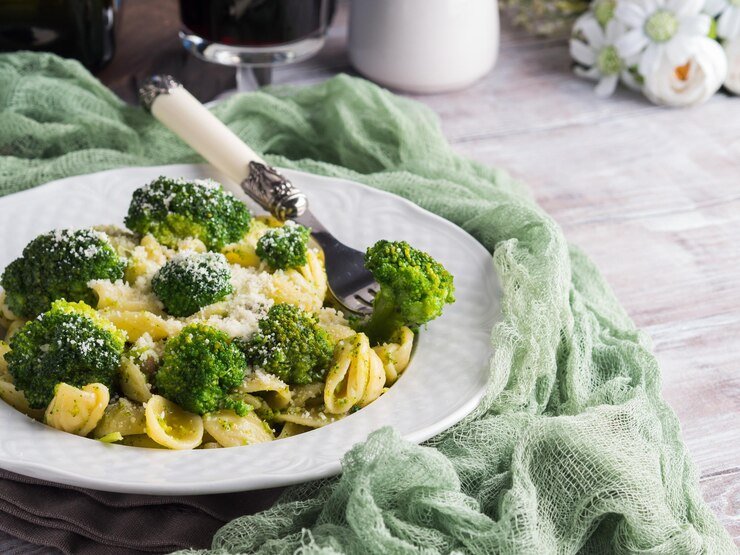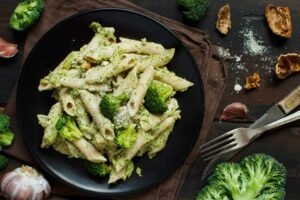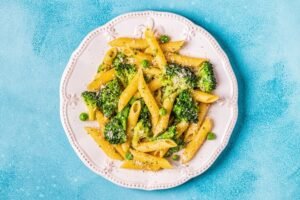Discover the Delights of Broccoli Pasta
Broccoli pasta combines the nutritious benefits of broccoli with the comforting taste of pasta. This section explores why this dish is so popular and looks at various recipe variations.
What makes Broccoli Pasta a popular choice?
Broccoli pasta is a favorite for its health benefits and taste. Rich in nutrients, it pairs well with pasta for a balanced meal. It’s ideal for anyone wanting more vegetables without losing flavor. Plus, its adaptability makes it suitable for different diets, from vegetarian to gluten-free. It’s also budget-friendly and easy to make, perfect for quick, satisfying meals.
Brief Overview of Recipe Variations
The basic recipe mixes pasta and broccoli with a simple sauce of garlic, olive oil, and parmesan. But there are many twists:
- Creamy Variations: Add cream or béchamel for a richer taste.
- Protein-Enhanced Variations: Include chicken, bacon, or shrimp for extra protein.
- Vegan Variations: Use vegan cheeses or cashew cream.
- Flavor Twists: Throw in sun-dried tomatoes, pine nuts, or capers for extra zest.
These options cater to diverse tastes and needs, keeping broccoli pasta exciting and versatile.
Ingredients and Equipment Needed for Broccoli Pasta
To prepare a delightful broccoli pasta dish, you’ll need a collection of key ingredients and some basic kitchen tools. This section provides a detailed list of what you’ll need to gather before cooking.
Essential Ingredients for Broccoli Pasta
Broccoli pasta requires a few staple ingredients that blend together to create a tasty and wholesome meal. Here’s what you’ll typically need:
List of Ingredients
- Broccoli: One or two large heads, depending on the number of servings.
- Pasta: About 12 ounces of your choice of pasta, such as fusilli, penne, or spaghetti.
- Olive Oil: A few tablespoons for cooking and extra for drizzling.
- Garlic: Two or three cloves, minced, for a flavor base.
- Parmesan Cheese: Half a cup, freshly grated, for mixing into the pasta and garnishing.
- Salt and Pepper: For seasoning to taste.
- Optional Enhancements: Red pepper flakes for heat, lemon zest and juice for freshness, or a handful of fresh herbs like basil or parsley for garnish.
These ingredients form the foundation of your dish but can be adjusted based on personal preferences or dietary restrictions.
Necessary Kitchen Tools
Preparing broccoli pasta doesn’t require fancy equipment but having the right tools can make the process smoother and more enjoyable.
List of Equipment
- Large Pot: For boiling pasta and blanching broccoli.
- Strainer or Colander: To drain the pasta and broccoli.
- Skillet or Large Pan: For sautéing garlic and combining ingredients.
- Cheese Grater: For fresh parmesan.
- Garlic Press (optional): If you prefer a finer garlic mince.
- Mixing Spoon or Tongs: To toss the pasta and sauce together.
- Measuring Cups and Spoons: For accurate ingredient portions.
With these ingredients and tools ready, you’re set to create a delicious broccoli pasta meal that’s sure to impress.
Step-by-Step Cooking Instructions
Creating a delicious broccoli pasta dish involves simple steps from preparation to plating. Follow these detailed instructions to ensure every aspect of your meal turns out perfectly.
Preparing the Ingredients
Before you begin cooking, it’s crucial to prepare your ingredients to streamline the cooking process. Start by washing the broccoli thoroughly under cold water. Trim off the large leaves and remove the tough ends of the stalks. Cut the broccoli into bite-sized florets to ensure they cook evenly and are easy to eat. Set aside.
Next, measure your pasta. If you’re using dried pasta, about 12 ounces will serve four people generously. Set your pasta aside so it’s ready to go into boiling water.
Peel and mince the garlic cloves; the finer, the better for a smooth, integrated flavor in the sauce. If you’re using additional ingredients like red pepper flakes, lemon zest, or fresh herbs, prepare these as well. Grate the parmesan cheese and set aside enough for mixing into the pasta and some for garnishing the finished dish.
With all ingredients prepped, you’re ready to start the cooking process, which will blend all these components into a savory, comforting dish.
Cooking Process Explained
Begin by boiling a large pot of water with a pinch of salt for the pasta. Once the water is boiling, add the pasta and cook according to the package instructions until al dente. Approximately two minutes before the pasta is done, add the broccoli florets to the same pot. This technique not only saves time and dishes but also enhances the broccoli with the pasta’s starchy cooking water, adding flavor and helping the sauce adhere later.
While the pasta and broccoli are cooking, heat a large skillet or pan over medium heat and add olive oil. Once hot, add the minced garlic (and optional red pepper flakes) to the skillet. Sauté for about a minute until the garlic is golden and fragrant, but be careful not to burn it.
When the pasta and broccoli are cooked, reserve a cup of the pasta water before draining. This starchy water is a key ingredient in creating a silky, emulsified sauce that clings beautifully to the pasta.
Finishing Touches and Plating
After draining the pasta and broccoli, return them to the pot (heat turned off) to mix in the sauce. Pour the sautéed garlic (and oil) over the pasta and broccoli. Add the grated parmesan cheese and about half a cup of the reserved pasta water to begin with. Toss everything together vigorously. The heat from the pasta will melt the cheese, creating a creamy sauce. If the pasta seems too dry, add more pasta water until you reach the desired consistency.
Season with salt and pepper to taste, and if you’ve prepared lemon zest or juice, add it now for a refreshing zing. If using fresh herbs like basil or parsley, sprinkle them on top for added color and flavor.
To serve, divide the pasta among plates or bowls. Garnish with additional parmesan cheese and a drizzle of olive oil for richness. Serve immediately, while it’s warm and the flavors are at their peak. This dish pairs beautifully with a simple side salad or a slice of crusty bread to complete the meal. Enjoy your homemade broccoli pasta, a dish that combines nutrition, comfort, and flavor in every bite.
Nutritional Benefits of Broccoli Pasta
Broccoli pasta not only delivers on taste but also offers significant health benefits. This section explores the nutritional advantages of incorporating broccoli into your pasta dishes, focusing on both the general health benefits of broccoli and the specific nutritional content of the dish.
Health Benefits of Broccoli
Broccoli is a powerhouse of nutrients, recognized for its extensive health benefits. Rich in vitamins C and K, it also provides good amounts of folate, potassium, and fiber. Vitamin C boosts the immune system and acts as a potent antioxidant, while Vitamin K is crucial for bone health and wound healing. The fiber in broccoli aids in digestion and helps maintain a healthy gut.
Furthermore, broccoli contains compounds like sulforaphane, which studies suggest have anti-inflammatory properties and may reduce the risk of heart disease and cancer. Regular consumption of broccoli can also help manage blood sugar levels, beneficial for individuals with diabetes. Its nutrient density, combined with low calories, makes broccoli an excellent choice for those looking to maintain or lose weight without sacrificing nutritional intake.
Caloric and Nutritional Content of the Dish
A typical serving of broccoli pasta is nutritionally balanced, making it a hearty and healthy meal option. On average, a serving contains approximately 400-500 calories, depending on the specific ingredients used, such as the type of pasta and whether cream or cheese is added.
The dish is high in carbohydrates from the pasta, providing energy, while the broccoli offers dietary fiber which promotes satiety and aids in digestion. The inclusion of olive oil adds healthy fats, important for heart health and absorption of fat-soluble vitamins. If parmesan cheese is used, it contributes calcium and protein, enhancing the meal’s nutritional profile.
Overall, broccoli pasta is a wholesome dish that combines essential macronutrients and micronutrients, supporting overall health while satisfying hunger. This makes it an excellent option for a nutritious meal that doesn’t compromise on flavor or substance.
Creative Variations to Try
Broccoli pasta is a versatile dish that can be customized to suit various tastes and dietary needs. This section explores creative ways to modify the traditional recipe, including alternative ingredients and substitutions, as well as vegan and gluten-free versions, ensuring everyone can enjoy this delicious meal regardless of their dietary restrictions.
Alternative Ingredients and Substitutions
To keep broccoli pasta exciting, consider experimenting with different ingredients. Instead of traditional pasta, try whole wheat, spelt, or legume-based pastas for added fiber and protein. For a nuttier flavor, substitute olive oil with walnut or almond oil. If you’re not a fan of parmesan, try other cheeses like pecorino or a mild goat cheese for a different taste profile.
Adding protein can transform this dish into a more filling meal; consider tossing in grilled chicken strips, pan-seared salmon chunks, or crispy tofu for plant-based protein. To spice things up, include a dash of chili flakes or a spoonful of pesto for a fresh, herby note. You can also mix in other vegetables like sun-dried tomatoes, olives, or spinach to boost the nutritional value and add color to the dish.
Vegan and Gluten-Free Versions
For those following a vegan or gluten-free diet, broccoli pasta can easily be adapted. Replace regular pasta with gluten-free options made from rice, corn, or quinoa. Ensure any other ingredients, like stock or condiments, are also gluten-free.
For a vegan version, omit cheeses or substitute with nutritional yeast or vegan cheese alternatives, which provide a similar cheesy flavor without dairy. Instead of using traditional cooking creams, opt for coconut cream or a rich cashew cream to achieve a creamy texture. Adding vegan protein sources like chickpeas or lentils not only makes the dish hearty but also increases its protein content, making it a balanced, plant-based meal.
These variations ensure that broccoli pasta remains a staple in any kitchen, adaptable to any dietary preference or culinary curiosity.
Frequently Asked Questions
Broccoli pasta is a versatile and popular dish, but many cooks have questions about perfecting and personalizing it. Here, we address some common inquiries to help enhance your cooking experience.
How can I make my broccoli pasta creamier?
To achieve a creamier broccoli pasta, consider adding a splash of cooking cream, full-fat milk, or a dollop of cream cheese to the sauce as you mix it with the pasta. Stirring in a spoonful of ricotta or mascarpone can also enrich the texture and flavor.
What pasta shapes work best with broccoli?
Short pasta shapes like penne, fusilli, or orecchiette are excellent choices for broccoli pasta. These shapes have nooks and crannies that catch and hold the sauce and small broccoli pieces, ensuring a flavorful bite every time.
Can I use frozen broccoli?
Yes, frozen broccoli is a convenient and effective substitute for fresh broccoli in pasta dishes. There’s no need to thaw it first; simply add it directly to the boiling pasta water during the last few minutes of cooking to ensure it heats through and retains its texture.
Tips for making broccoli pasta kid-friendly?
To make broccoli pasta more appealing to kids, try using fun pasta shapes like spirals or macaroni. Add a mild cheese, like cheddar, to the sauce, and consider blending the broccoli into the sauce to disguise the texture. Bright and colorful additions like sweet corn can also make the dish more visually appealing to young diners.
How to store and reheat leftovers?
Broccoli pasta leftovers can be stored in an airtight container in the refrigerator for up to three days. To reheat, add a little water or milk to the pasta to prevent it from drying out, and warm it in the microwave or on the stovetop over low heat, stirring occasionally until heated through. This method helps to preserve the texture and flavor of the pasta and broccoli.
Wrapping Up with Serving Suggestions
As you prepare to serve your freshly made broccoli pasta, consider these tips to enhance your dining experience. Whether you’re enjoying this dish as a quick weekday dinner or presenting it at a family gathering, these serving suggestions will help you make the most out of your meal.
Best Ways to Serve Broccoli Pasta
Broccoli pasta is best served hot, straight from the stove. For a visually appealing presentation, use a large, shallow bowl where you can spread the pasta evenly, allowing the broccoli and other ingredients to be displayed on top rather than sinking beneath the surface. Garnish with extra grated cheese, a sprinkle of fresh herbs, or even a few red pepper flakes to add color and interest. A final drizzle of good quality olive oil just before serving can enhance the flavors and add a touch of luxury.
Pairing Ideas with Drinks and Sides
Drinks
A light white wine, such as a Sauvignon Blanc or a Chardonnay, complements the fresh flavors of the broccoli and the richness of the pasta well. For a non-alcoholic option, a sparkling lemonade or an iced herbal tea can be refreshing.
Sides
A simple side salad dressed with a lemon vinaigrette makes a fresh, crisp contrast to the creamy pasta. Consider a mix of arugula, spinach, and other baby greens. For a heartier meal, serve with garlic bread or focaccia to soak up any leftover sauce.
internal Links to enhance your cooking experience
you’ll find carefully selected links to enhance your cooking experience. Whether you’re looking to explore ‘Tomato Cream Sauce for Pasta’ as a delightful alternative, or need inspiration for ‘Pasta Salad’ that complements your meal, these links will guide you to additional recipes. We aim to enrich your culinary journey, providing quick access to more dishes that might become new favorites. Happy cooking
- Tomato Cream Sauce for Pasta: You can link this page when discussing variations of the broccoli pasta recipe or if you mention sauces that pair well with pasta. Insert the link at the phrase « different pasta sauces. »
- Pasta Salad: If your article discusses side dishes or additional recipes that use pasta, this would be a good link to include. Place it at « additional pasta dishes. »
- Link: Pasta Salad
External Links and Recommended Anchor Texts:
This paragraph provides essential links to deepen the reader’s understanding of broccoli’s substantial health benefits. By directing readers to a well-researched source, they can explore the nutritional richness, antioxidant properties, and fiber benefits of broccoli in detail. These links not only enrich the factual content of the article but also reinforce the importance of incorporating such nutritious vegetables into daily meals for overall health and wellness.
- Nutritional Benefits: To highlight the various vitamins and minerals found in broccoli, you can link to Healthline’s article on the top health benefits of broccoli at the phrase « nutritional powerhouse. »
- Antioxidant Properties: When discussing the healthy aspects of including broccoli in your meals, embed a link to the same Healthline article at the mention of « potent antioxidants » to provide readers with detailed information on how these compounds help prevent diseases.
- Dietary Fiber: If your article talks about the fiber content in broccoli and its benefits for digestion, include a link at the term « good source of fiber. » This will give readers direct access to more detailed benefits regarding dietary fiber in broccoli.




1 réflexion au sujet de « Broccoli pasta »